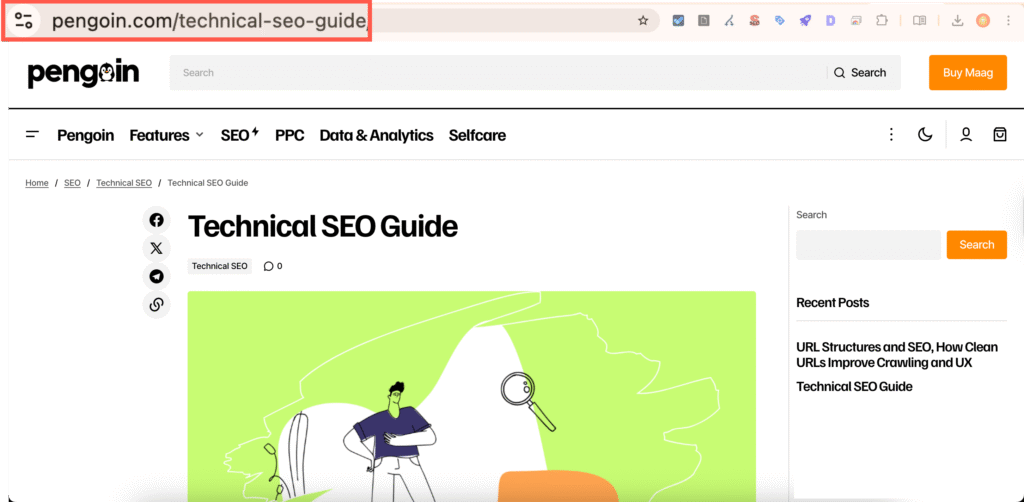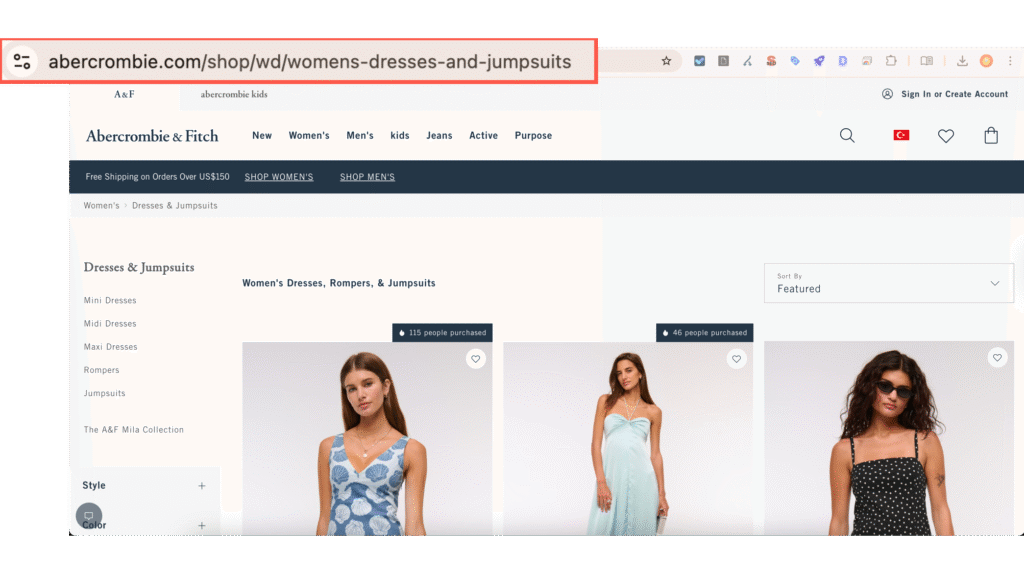URL Structures and SEO, How Clean URLs Improve Crawling and UX

Have you ever clicked on a search result only to see a messy, unreadable URL filled with numbers, symbols, or irrelevant folders?
It doesn’t inspire much confidence, does it?
Your website’s URL structure is one of the first things both users and search engines notice. It may not be the flashiest part of SEO, but it quietly influences how your content is crawled, understood, and clicked.
Clean URLs support better rankings, stronger user experience, and more efficient indexing. They help Google understand what your pages are about. And they help visitors trust that they’re landing somewhere useful.
In this guide, we’ll walk through why URL structure still matters, what makes a URL SEO-friendly, and how to get it right whether you’re running a blog, an online store, or a multi-location business.
Let’s begin by looking at why this seemingly small detail makes a big difference.
Why URL Structure Still Matters for SEO and UX
It’s easy to overlook URLs when you’re focused on content, backlinks, or Core Web Vitals. But your URL structure plays a foundational role in how Google and users interact with your site.
Subscribe to our mailing list to get the new updates!
For search engines, URLs help define the relationship between different pages. They act as breadcrumbs for crawling, signals for indexing, and sometimes even indicators of relevance. A clean, keyword-rich URL can reinforce what your page is about before Google even reads the content.
For users, URLs provide transparency. They show where they’re going, what type of page they’re visiting, and whether they can trust the link. Would you rather click on a URL that ends in /products/stainless-steel-water-bottle or /prd=12283&cat=98_sessionID=a1Bxy?
Exactly.
Clear URLs improve click-through rates by offering clarity. They also make it easier to share, copy, and reference pages which supports organic linking and user trust.
So what is link structure in SEO?
It’s the way your URLs are organized and how they relate to the overall structure of your website. Good link structure helps search engines crawl your site efficiently and users navigate without friction.
And while it’s tempting to think of URLs as a technical detail, they’re actually a long-term asset. When structured well, they support discoverability, trust, and long-term growth.
What Makes a URL SEO-Friendly
A good URL should make sense to both search engines and people. It should describe the page in a few clear words and give a hint of what to expect before anyone even clicks.
So how do you structure a URL for SEO?
It starts with a few simple principles. Clean URLs are:
- short and easy to read
- written in lowercase
- separated by hyphens, not underscores
- free of unnecessary parameters or clutter
- aligned with the page’s main keyword
For example, a strong URL might look like this:
yourdomain.com/seo-url-best-practices
It’s clear, consistent, and immediately gives context.
Compare that with this:
yourdomain.com/index.php?productID=4821&cat=22
That kind of structure not only confuses users but can also make crawling more difficult. Google has said that while it can process dynamic URLs, clean and static ones are preferred for both crawling and indexing efficiency.
Avoid adding stop words like “and”, “of”, or “with” unless they help with clarity. The goal is to keep your URL as lean as possible without losing meaning.
If you use categories in your URLs, make sure they are relevant and not overly nested.
For example:
- yourdomain.com/blog/seo-url-tips is good
- yourdomain.com/articles/blog/seo/seo-url-structure-best-practices is too long and diluted
Also, be mindful of case sensitivity. URLs are case-sensitive in many server environments, so always stick to lowercase to avoid duplication or 404 errors.
If you’d like to see how Google itself approaches URL structure, they’ve outlined their best practices clearly in their official guide: Google Search Central on URL Structure
Following these basics helps Google understand your content faster and gives users a reason to trust your links at a glance.
How to Structure URLs for Different Website Types
There’s no single perfect URL format that works for every site. A news blog has different needs than a product catalog or a location-based service. But the goal stays the same: make URLs easy to crawl, easy to understand, and easy to trust.
Blogging and Content Sites
If your site is content-heavy, you’ll want URLs that reflect topics clearly. Avoid including dates in the slug unless you’re running a time-sensitive publication. Dates can make content look outdated, even if it’s evergreen.
Instead of this:
yourblog.com/2023/05/technical-seo-guide
Prefer this:
yourblog.com/technical-seo-guide

Keep slugs short and relevant. Use the main keyword or phrase from your title, but skip filler words. And if you organize content by category, keep category names concise and purposeful.
E-commerce Sites
Shop URLs should be functional and clean. The ideal format for a product page might look like:
yourstore.com/products/waterproof-hiking-boots
Avoid parameters like ?id=382 or long filters in the URL unless you absolutely need them for functionality.
If your products exist in multiple categories, use canonical tags to avoid duplicate content issues. Choose one preferred version of the product URL and point all others to it.
Local Businesses and Directories
For local SEO, location in the URL can help reinforce relevance, especially if you operate in multiple cities.
For example:
yourbusiness.com/dentist-new-york
yourbusiness.com/hvac-los-angeles
This format makes it clear who you serve and where. It also aligns naturally with what users search for when looking for local services.
So what is the best URL structure for local SEO?
It’s one that includes your target location, avoids unnecessary folders, and mirrors how users actually phrase their queries.
How Popular CMS Platforms Handle URL Structure for SEO
Your CMS can help or hinder your URL strategy. Some platforms offer near-complete control, while others force certain structures that you’ll need to work around. Understanding the strengths and limitations of your system helps you make the most of your SEO opportunities.
WordPress
WordPress is widely favored for SEO, and URL control is one of the reasons why. Its permalink settings allow you to define clean, readable slugs right out of the box. You can customize URLs for posts, pages, and even categories. If you use plugins like Yoast or Rank Math, you get even more flexibility. Just avoid default structures like /?p=123 or /archives/2024/04/post-name which add unnecessary length and lower clarity. Instead, opt for short, lowercase slugs that reflect the content naturally. WordPress does this well. When configured correctly, it gives you total control.
Shopify
Shopify offers limited flexibility when it comes to URLs. While you can edit product and page slugs, you can’t remove built-in folders like /products/, /collections/, or /pages/. This means your URL might look like yourstore.com/collections/mens-shoes rather than something cleaner like yourstore.com/mens-shoes. From an SEO perspective, this isn’t a dealbreaker, but it does mean you’ll need to be more intentional with other elements like title tags, product descriptions, and internal linking to offset structural rigidity.
Other CMS Platforms
Webflow provides solid control over slug naming and folder structure. It’s a good middle ground between design freedom and SEO flexibility. Wix has improved in recent years but still tends to generate lengthy or cluttered URLs if not configured manually. Squarespace has limited URL customization as well, which can lead to redundant folder paths or date-based URLs in blogs. These platforms can still rank, but they require extra attention to keep URLs clean and logical.
Choosing a CMS with your SEO priorities in mind can make a major difference over time. If you’re locked into a system with strict structures, compensate with clarity, internal links, and excellent metadata.
Tips for Creating a Strong URL Structure from the Start
A clean URL structure doesn’t happen by accident. The earlier you plan for it, the more scalable and SEO-friendly your site becomes. Whether you’re launching something new or cleaning up an existing site, the goal is the same. Create a system that makes sense for both people and search engines.
Start with your site’s hierarchy. Think about your main categories, key pages, and how they should be grouped. Your URL structure should mirror your navigation and your information architecture. If your navigation is clean, your URLs will follow suit. Keep folder depth shallow wherever possible. Instead of yourdomain.com/shop/categories/footwear/mens/winter/boots, try yourdomain.com/mens-winter-boots.

Use hyphens to separate words, not underscores. Hyphens are easier to read and preferred by Google. Stick to lowercase to avoid case-sensitive issues on some servers. Keep slugs short but meaningful. Three to five words is usually enough. Focus on your target keyword, but make sure the slug still reads naturally.
If you need to update URLs, always use 301 redirects to preserve link equity and avoid broken pages. Changing URLs without proper redirection is one of the fastest ways to tank your SEO momentum. Also, avoid adding stop words unless they’re essential for clarity. Clean doesn’t mean robotic. It means precise.
So how to structure a URL for SEO? Plan it first. Keep it short. Make it human-readable. And always align it with the intent of the page.
Common Mistakes to Avoid When Structuring URLs
Even with the best intentions, small URL mistakes can have lasting consequences. They can confuse users, disrupt crawl paths, or dilute your site’s authority. The good news is most of these issues are easy to prevent if you know what to look for.
One of the most common problems is using IDs or meaningless strings instead of real words. URLs like yourdomain.com/page?id=1243 tell neither users nor search engines anything useful. Replace those with clear, keyword-relevant slugs that reflect the page topic.
Another frequent issue is including unnecessary words. Terms like “a,” “the,” “and,” or “of” often add clutter without improving clarity. That said, don’t remove words at the cost of natural flow. The goal is readability with purpose.
Auto-generated slugs are also a hidden risk. Many CMSs generate URLs from titles but truncate or repeat terms in awkward ways. Always review slugs before publishing. A good slug should be intentional, not accidental.
Changing URLs without setting up 301 redirects is one of the more damaging errors. It breaks inbound links, loses link equity, and often creates dead ends for both users and bots. If a page’s slug must change, redirect the old one properly and update any internal links that point to it.
Finally, watch out for near-duplicate URLs caused by category overlaps, filtering systems, or inconsistent casing. Two URLs leading to the same content can cause crawl inefficiencies and cannibalize ranking signals. Use canonical tags to tell Google which version to prioritize.
A well-structured URL helps your page perform better from day one. A poorly structured one makes everything harder. These common mistakes are avoidable. Review your pages, fix what you can, and move forward with a clearer system.
How Clean URLs Improve Crawlability and UX
Clean URLs aren’t just about aesthetics. They influence how your website is understood, navigated, and prioritized by both users and search engines. A well-structured URL makes crawling easier, improves indexing consistency, and creates a better overall experience.
For Google, shorter and simpler URLs reduce friction during crawling. A flat, logical structure helps bots move efficiently from one page to another. When URLs are cluttered with parameters, session IDs, or confusing folders, crawlers waste resources trying to make sense of them. This can delay indexing or cause important pages to be missed.
From a user perspective, clean URLs build trust. They give a clear idea of what the page is about and feel more reliable. A URL like yourdomain.com/guides/url-structure-seo reassures visitors that they’re clicking into a relevant, focused page. It’s easy to share, easy to remember, and easy to link to.
URL clarity also supports anchor text usability. When someone links to your page using the URL as the anchor, it still communicates meaning. That’s not the case if the link looks like yourdomain.com/page.php?id=8732.
So how do I structure my website for SEO?
Start with a clean folder structure. Make sure each section of your site flows logically. Keep URLs short but informative. Use keywords that align with the page’s content. And avoid technical clutter that adds no value. Your URLs should guide, not confuse.
In short, every clean URL is a signal. It tells Google how your site is organized. It tells users where they are and what to expect. And when done well, it helps both find what they’re looking for faster.
Final Thoughts on Getting URL Structure Right
URL structure might seem like a minor detail, but it touches nearly every part of your site’s performance. It affects how quickly Google can crawl your pages, how confidently users click your links, and how well your content stands the test of time.
Clean URLs are not a hack or a trend. They are a reflection of a site that is organized, thoughtful, and built with both people and machines in mind. When your URLs are clear, concise, and aligned with your content, you remove barriers. You make it easier to find, easier to trust, and easier to grow.
You don’t need to change everything at once. Start with a few core pages. Review their slugs. Remove any clutter. Add redirects if needed. Then keep that discipline moving forward as your content grows.
If you’re working on a new project, this is the perfect time to build a scalable structure from the beginning. If your site is already live, an audit of your top URLs can still bring meaningful improvements.
SEO is about sending strong, consistent signals. A clean URL is one of the easiest and most effective signals you can control.
What do your URLs say about your content? And what would it look like if they said it better?
Wanna see how your website perform?
Let's run a comprehensive technical SEO audit for your website and share a compelling SEO strategy to grow your online business.
SEO Audit →


